Vintage Fashion Houses & Designers
Rue de la Paix, or within a stone's throw of there, are the celebrated style creators—Beer, Cheruit, Dufuillet, Doucet, Jenny, Lanvin, Madeleine & Madeleine, Paquin, Paul Poiret, Premet, Redfern, Worth.
The Parisian style artists, when questioned about their art, are very careful to explain that they are not concerned with the styles that are popular today, but with the styles that are going to be popular tomorrow.
They are. according to their own bashful admissions, dress prophets. This may be true; but I would like to go on record to the effect that If any weather prophet or stock-market prophet were to make as many errors in prophecy as the Parisian drew prophets make he would be obliged to quit the prophecy business and devote himself to the haw subtle art of coal shoveling or brick passing.
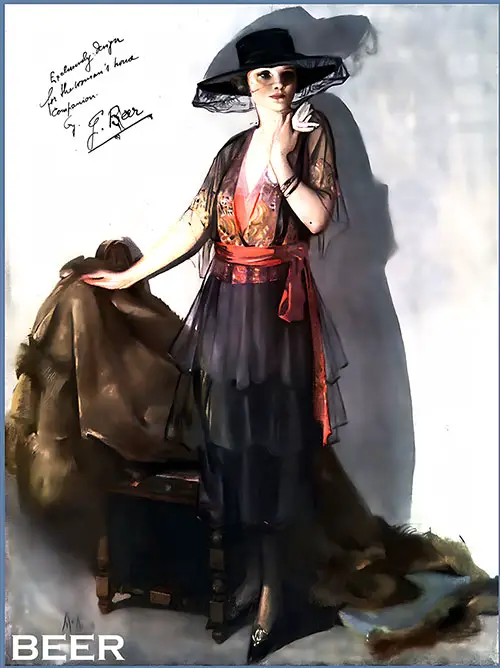
Gustav Beer: Parisian Elegance and the Tailored Splendor of Early 20th-Century Fashion
Gustav Beer, a prominent Parisian fashion designer active from the Edwardian era through the Roaring Twenties, was a couturier who balanced structure with softness, tailoring with femininity. His designs reflect not only Parisian flair but also the cosmopolitan culture of the steamship traveler, who sought refinement, ease, and impact whether at sea or in society salons.
Beer's collections, as documented in this visually rich article, are an ideal interdisciplinary resource that:
🎓 Supports fashion and design history courses
🧬 Informs genealogical context for family photos
🛳️ Illuminates the style of upper-class passengers aboard ocean liners
🖋️ Offers a rich primary source for students writing essays on gender, luxury, or modernity
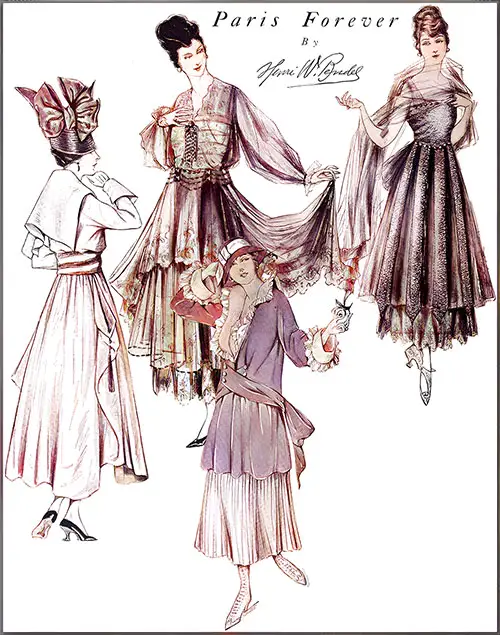
Henri Bendel: The Spirit of Paris in American Fashion, 1916
This stunning collection from Harper’s Bazar (1916), curated by GG Archives, spotlights Henri Bendel as a premier tastemaker who bridged Parisian haute couture and American high society at the height of the WWI era. Through vibrant imagery, lyrical descriptions, and fashion journalism, the article offers a portrait of Bendel’s design philosophy—one rooted in elegance, adaptability, and a timeless French spirit.
🎯 Why it matters: This article is invaluable for exploring the role of fashion in cultural identity, transatlantic influence, and how wartime solidarity, artistic craftsmanship, and innovation intersected in couture.
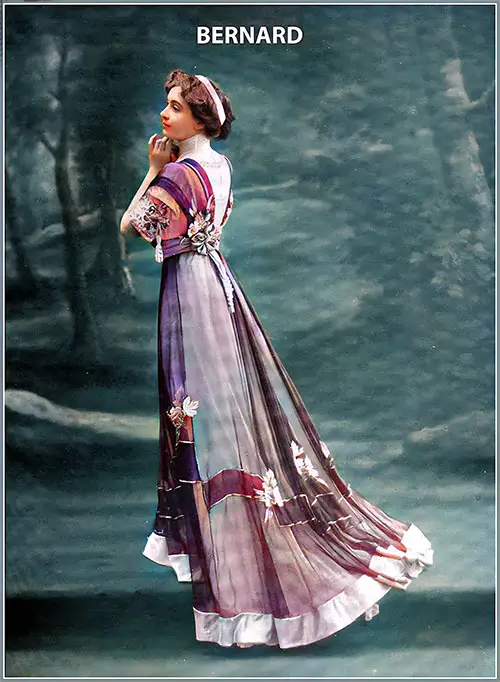
Alice Bernard: Parisian Designer for the Traveling Elite (1908–1926)
Alice Bernard, one of Paris’s most quietly influential designers of the early 20th century, crafted a fashion house that merged tailoring precision with luxurious femininity. Though lesser known than Chanel or Lanvin today, Bernard’s designs were widely respected and enthusiastically worn by transatlantic travelers, performers, and high society patrons on both sides of the Atlantic.
This article and the accompanying images from periodicals such as Harper’s Bazar, Les Modes, and Silk offer a rare primary source window into the textures, colors, and silhouettes that defined Bernard’s fashion legacy from pre-WWI into the mid-1920s.
It’s a goldmine for:
🎓 Fashion history classes
📚 Social studies focused on women’s roles and travel
🧬 Genealogical research
📸 Visual art & design education
🛳️ Maritime historians exploring luxury liner culture

Jeanne-Adele Bernard - Parisian Fashion Designer - 1920
One of the largest and best collections of tailor-mades and coats I have ever seen is that shown by Bernard. Although all the other branches of the sartorial art are equally well represented here, the tailleurs stand out as models of elegance.
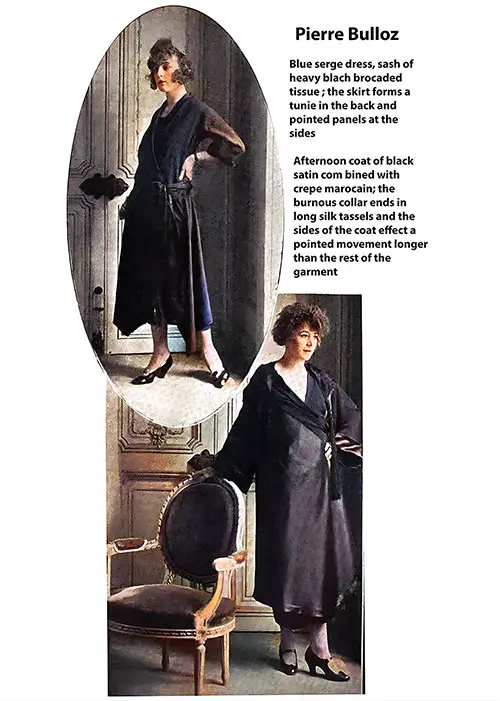
Pierre Bulloz: Parisian Poetics in Silk and Satin—A Couturier for the Stage, the Salon, and the Sea
Pierre Bulloz's legacy in early 20th-century Paris fashion is a remarkable synthesis of visual artistry, technical tailoring, and theatrical sensibility. His background as a painter gave his work an unmistakable attention to form, color, and human movement, while his understanding of couture made him a favorite among European royals, opera stars, and transatlantic travelers alike.
🧳 For the historically inclined: Bulloz offers a fascinating case study in Parisian modernism, gendered aesthetics, and global commerce—as relevant to the halls of Versailles as to the saloons of Cunard liners.
Pierre Bulloz, a distinguished Parisian fashion designer whose artistry, daring innovation, and theatrical flair defined a compelling intersection between fashion, femininity, and global travel culture.

Madame Cara - Parisian Fashion Designer - 1920
Cara is making a name for herself; before establishing her own house, which she personally supervises in every detail, she was designer at Paquin's; what more excellent recommendation, especially if you have seen her models.

Louise Chéruit - Parisian Fashion Designer - 1920
An extensive and brilliant collection is that shown by Cheruit—consistent in the sense that the same remarkably clear, good line is preserved throughout, and very varied as to stuffs, colors, and trimmings.
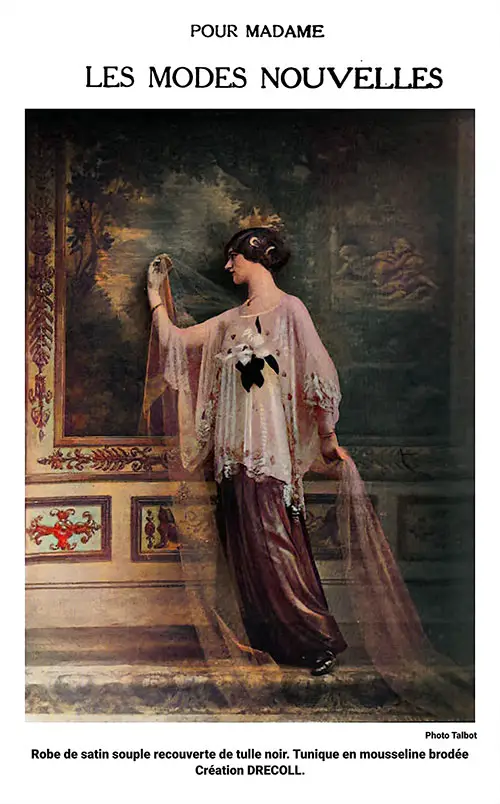
Christopher Drécoll: Parisian Fashion for Ocean Travelers and Elite Society (1908–1921)
Christopher Drécoll’s Parisian fashion house crafted garments not merely for show, but for the active, elegant woman—especially those of the First Class transatlantic traveler. His designs, rich in texture, intricate in detail, and practical in form, offered fashionable solutions for a life in motion—from shipboard promenades to cosmopolitan arrivals in London, Paris, or New York.
For students, genealogists, historians, and fashion enthusiasts, Drécoll offers a rare glimpse into the intersection of global luxury, performance wear, and society fashion at the dawn of the 20th century.
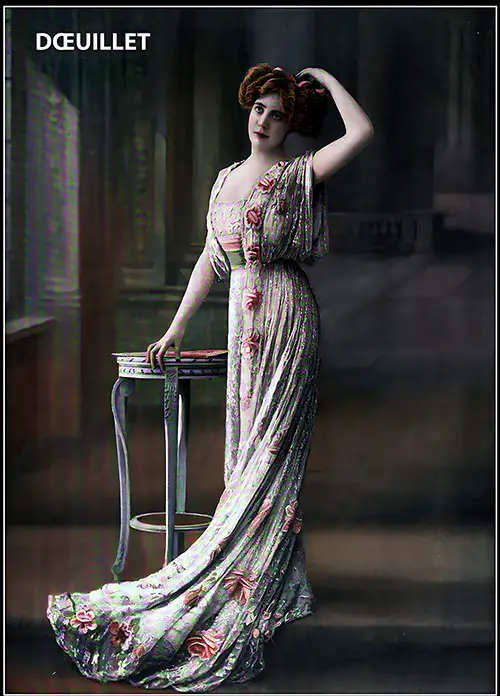
Georges Dœuillet: Parisian Couture and the Art of Refined Travel Fashion (1908–1914)
Georges Camille Dœuillet, one of Paris's most revered couturiers of the early 20th century, built a fashion house that combined timeless refinement with practical elegance. A favorite of the Parisienne elite and a trusted name for travelers and society brides alike, Dœuillet's creations were ideal for the transatlantic traveler, the upper-class hostess, and the fashion-forward modern woman.
Through detailed descriptions and stunning period illustrations, this article brings Dœuillet's couture masterpieces to life. Teachers, students, genealogists, and historians will find in this designer’s work a valuable window into fashion’s dialogue with gender, class, and luxury during the ocean liner era.

Knitted Elegance & Travel-Ready Couture: The House of Dorat, 1920–1922
The House of Dorat, a relatively young but bold force in early 1920s Parisian couture, brought a fresh blend of craftsmanship, youthfulness, and innovation to the fashion world. Specializing in silk and woolen jersey, knitted sportswear, and tailored garments, Dorat’s designs weren’t just fashionable—they were functional, making them especially appealing to the modern traveler, including those embarking on ocean voyages.
For teachers, students, genealogists, and fashion historians, this profile offers valuable insights into:
Post-WWI women’s lifestyle shifts
The rise of knitted luxury
Changing silhouettes that mirrored freedom and elegance
The kind of wardrobes found in ship trunks en route to European tours or coastal destinations 🌊👗

Nicole Groult - Parisian Fashion Designer - 1920
Madame Nicole Groult, wife of the celebrated decorator, founded her house ten years ago and became well-known at once by her original ideas and personal way of adapting them to clothes. She comes honestly by talent as the sister of Paul Poiret.

Jeanne Hallée - Parisian Fashion Designer - 1920
The old firm of Jeanne Hallée now belongs to M. Kamp and is directed by his wife, Madame Suzanne, who has made a great success of the much-restored establishment.

Paris to the Promenade Deck: The Fashion Legacy of Berthe Hermance, 1919–1921
The name Berthe Hermance may not appear in modern fashion glossaries, but to the early 20th-century traveler, socialite, or theater star, it represented refined Parisian elegance tailored for mobility and distinction. This richly illustrated profile—sourced from the Garment Manufacturers’ Index and various French fashion publications—offers an extraordinary view into post-WWI couture and the golden age of transatlantic ocean travel, when what you wore onboard mattered just as much as where you were going.
This feature is a must-read for teachers, students, genealogists, fashion historians, and those researching transatlantic social life in the 1919–1921 period, offering rare insight into couture trends that bridged Parisian ateliers and the grand ocean liners of the era.

House of Jenny - Parisian Fashion Design Firm - 1920
Simplicity and great unity of color and design, mark the creations of Mme. Jenny. The entire collection presents a straight unbroken silhouette, very chic and plain but for the various embroideries; the craze for rich, elaborate trimmings is present everywhere, and we may congratulate the Parisian dressmakers on the ingenuity displayed to make them different.
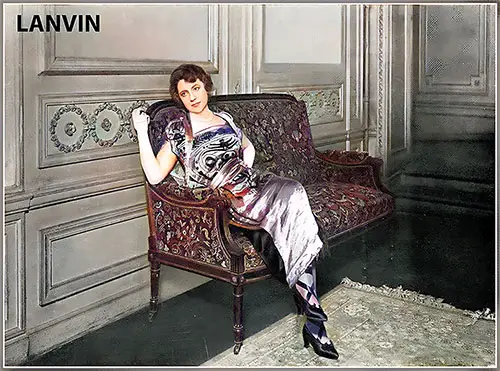
Jeanne Lanvin: Youth, Elegance & Transatlantic Style in the Age of Steamships (1908–1920s)
Jeanne Lanvin (1867–1946), one of the most visionary couturières of early 20th-century Paris, made fashion that transcended the salon and swept across continents—especially by steamship. This archival article, with stunning images from Harper’s Bazar, Les Modes, and other leading publications, offers a vibrant cross-section of Lanvin’s output during her golden years: 1910 to the early 1920s, when fashion met modern femininity, youth culture, and international travel.
🌍 Lanvin’s designs were worn by the young debutantes of New York, schoolgirls boarding transatlantic liners, stage stars in Parisian theaters, and women of independent means with a suitcase full of satin and taffeta.
This makes the article a treasure trove for educators, students, and researchers interested in:
🧳 Transatlantic travel culture
🧵 Fashion history
💃 Women's roles in early 20th-century society
🧬 Genealogy (especially identifying social class & lifestyle clues in family photos)
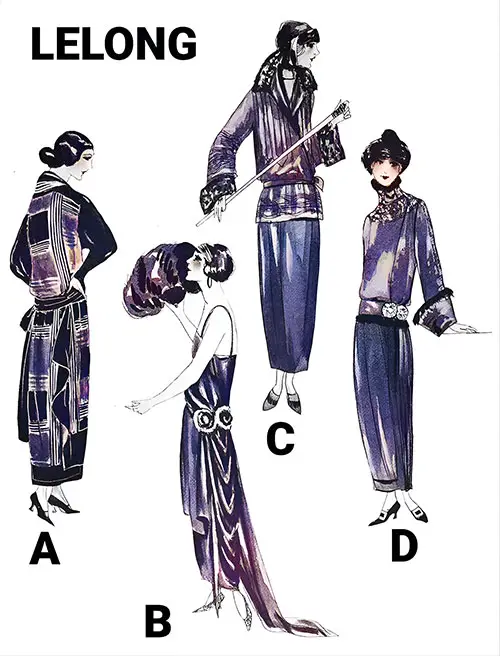
Lucien Lelong: Parisian Fashion Pioneer Who Bridged Couture, Cinema, and Ocean Travel Elegance
Lucien Lelong, a towering figure in early 20th-century Parisian couture, emerges from this rich GG Archives collection not merely as a designer of gowns, but as a visionary whose style, management, and philosophy shaped the future of fashion. His relevance stretches beyond the runway—into ocean travel, American consumer culture, and women’s evolving roles in society 🌍🧳👗.
For educators, students, genealogists, and historians, this article is a fashion time capsule, providing an in-depth look at the evolution of modern elegance. With ties to Hollywood stars, innovations in fashion business practices, and iconic textile developments, Lelong’s story is perfect for research, essays, and educational projects alike 📝📖.

House of Madeleine et Madeleine - Parisian Fashion Design - 1920
Madeleine et Madeleine, established just a year before, have found it necessary to enlarge their premises under growing success. The first Madeleine used to be with Drecoll, the second Madeleine with Jeanne Hallée. This young and promising house is financed by a group of old French nobility among whom are the Comte de Munand Comte Hubert de Montégut.

Martial et Armand: Tailored Elegance and Seaside Sophistication for the Modern Parisienne
Since its founding in 1902 and under the sophisticated direction of Madame Vallet, Martial et Armand evolved into a dynamic force in Parisian couture, offering sharp tailoring, rich fabrics, and experimental silhouettes that harmonized refinement with modern flair.
From the elite promenades aboard ocean liners to afternoon teas in garden salons, Martial et Armand’s creations exemplified how fashion moved with women—gracefully, purposefully, and always in style. 🛳️💃

Mayer et Bulloz - Parisian Fashion Design House - 1920
Maurice Mayer, the well-known tailor, went into partnership a year ago with an equally old Parisian, Bulloz, who manages the firm. The happiest results have been received from this connection. The efforts of their reputed designer, Madame Burling, contribute to make their collection this winter unique.
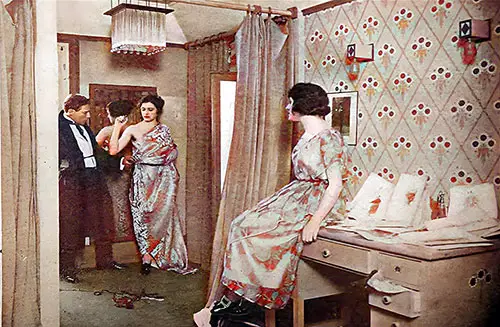
Melnotte-Simonin: The Painter of Parisian Fashion Who Designed for Motion, Color, and Grace
At a time when post-WWI Paris was reawakening its creative spirit, the couturier Melnotte-Simonin stood out for his artistic reverence and progressive design. This captivating article paints an elegant portrait of a designer devoted not only to draping the body, but to clothing it in nature, light, and movement. 🍃💡
For fashion historians, the piece reveals a transition period from structured Edwardian silhouettes to the flowing, expressive styles of the early 1920s. For teachers and students, it provides a lens into how clothing and color were shaped by postwar sentiments, artistic movements (like Impressionism 🎨), and evolving gender roles.
For ocean travel scholars, this fashion house represents the haute couture ideals that passengers sailing aboard luxury liners—like the Cunard or White Star Line—would aspire to wear during promenades, teas, and formal dinners at sea. 🌊🛳️
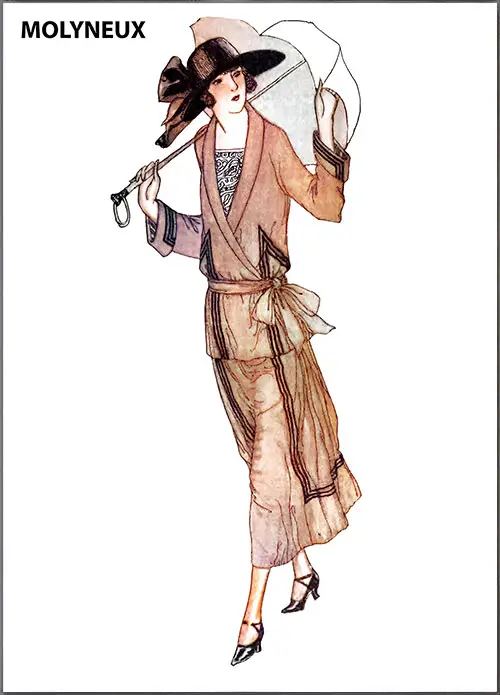
Edward Molyneux: Designing for Ocean Travel, Elegance, and Empowerment in the 1920s
From the salons of Rue Royale to the grand transatlantic liners, Edward Molyneux dressed the world’s elite in some of the most graceful and modern garments of the 1920s. This stunning archival profile from the GG Archives provides a rare window into the evolution of modern fashion, the rise of the cosmopolitan woman, and the seamless blending of travel and couture.
🌍 Molyneux's work reflects the changing world of post-WWI society: women were becoming more mobile, more independent, and increasingly visible in the public sphere—especially on ocean liners, in European capitals, and on glamorous world tours.
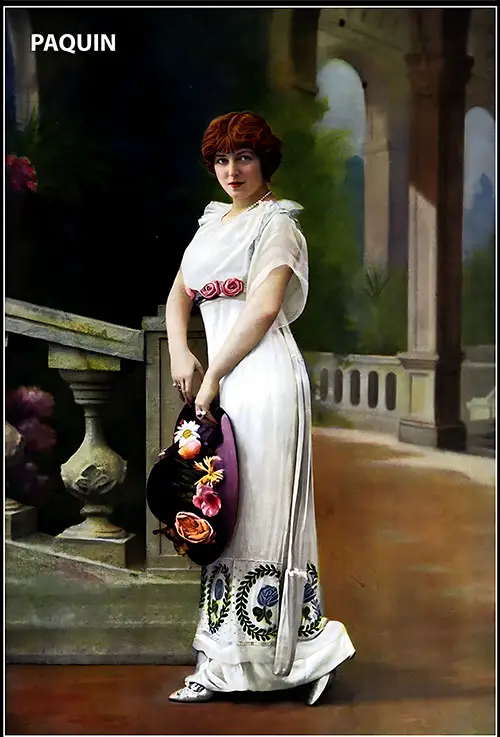
Jeanne Paquin: Couturière of the Modern World—Fashion, Feminism, and Ocean Elegance
Mme. Jeanne Paquin (1869–1936), known as “The Czarina of Dress,” built one of the most powerful and influential fashion houses of the Belle Époque and early 20th century. Her career fused innovation, business acumen, artistic flair, and a groundbreaking approach to customer experience—all while becoming a role model for ambitious women across the globe.
For educators and students, the House of Paquin offers a perfect lens into:
- The emergence of modern fashion marketing
- The evolution of women’s public identity through dress
- Cross-continental fashion exchange, especially for transatlantic travelers and elites
- Genealogical clues about dress customs, millinery, or tailoring found in family photos or passenger lists
Jeanne Paquin—an icon of haute couture and a defining figure in the evolution of fashion as it intersected with women’s independence, social mobility, and transatlantic travel. This resource-rich page is crafted for teachers, students, genealogists, and fashion historians, with relevant visual highlights, terminology, and educational insights. 🎓👒🛳️

Jean Patou - Parisian Fashion Designer - 1920
Jean Patou has but lately established himself in the rue Saint Florentin with the firm intention of succeeding. His extraordinary capabilities, both as manager and creator of models, have been proven by an ever-increasing stream of American buyers.

House of Peron - Parisian Fashion Design - 1920
The director of this rising house, M. de Fontenay, began his career with Paquin, went from there to Lucile's, with whom he was connected for many years. His business capacity and taste have been proven by the excellent designers and workers he has selected for his new premises, 2 rue de la paix, which bid fair to rival our greatest houses.

Paul Poiret - Parisian Fashion Designer - 1920
Paul Poiret's re-appearance since the Armistice has been hailed with delight by the many who admired his creative genius before the war. It suffices to add that the management of his house is the same and his ideas better than ever.

Madame Premet - Parisian Fashion Designer - 1920
The Place Vendôme, for many years the center of Parisian elegance—the home of higher dressmaking circles, boasts no smarter or better-known firm than Premet, of which M. Winter is the able director.
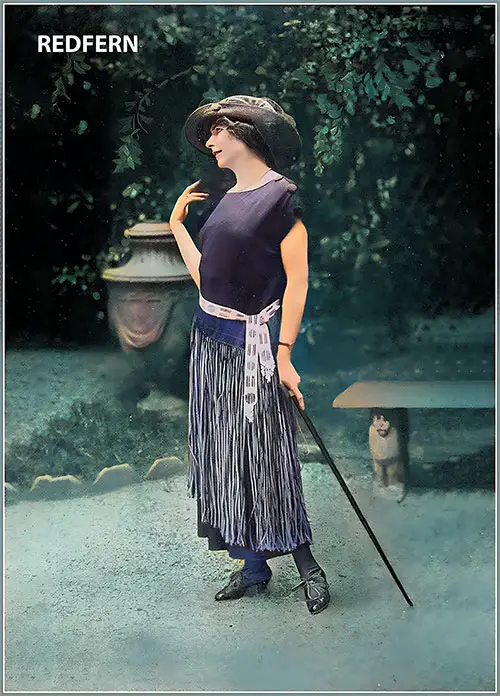
🎩 House of Redfern: Tailored Elegance from Yachting Suits to Evening Gowns (1855–1930s)
The GG Archives' in-depth profile of the House of Redfern is a masterclass in historical fashion documentation, offering an unparalleled window into the world of early 20th-century couture and its connections to ocean travel, elite society, and global culture. 🎩🚢
Originally a British tailoring firm based in Cowes, Redfern evolved into one of the leading fashion houses in Paris, dressing royalty, aristocrats, actresses, and travelers in equal measure. Through a mix of vivid narrative, captivating photography, and remarkable primary sources, this page is ideal for:
👗 Fashion Historians – tracing the evolution of couture and high-end tailoring
📚 Teachers & Students – using fashion to study class, gender, and design history
🌍 Genealogists – identifying the cultural markers tied to elite travel and attire
🎭 Theater & Costume Designers – understanding stage vs. real-world fashion influence
🧳 Ocean Travel Scholars – observing how fashion shaped the image of travelers aboard luxury liners like the RMS Titanic

John Tollmann - Parisian Fashion Designer - 1920
The establishment of John Tollmann is pervaded by his interesting personality. His great love of color and scenic effects have made him famous as a stage decorator and costumer.

House of Worth - Parisian Fashion Design Firm - 1920
The house of Worth, which has dressed queens for half a century, still keeps from father to son its reputation of unrivalled elegance. The style at Worth's is most varied, while he keeps up his reputation for dazzling evening gowns.
